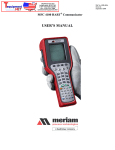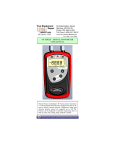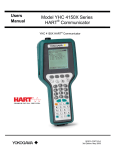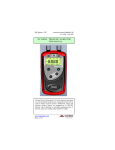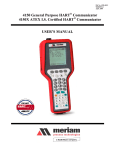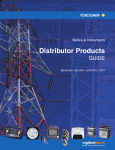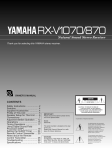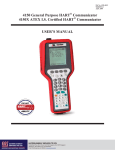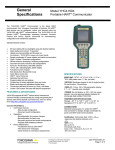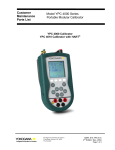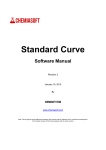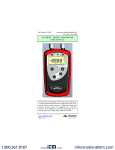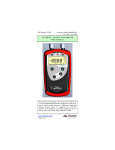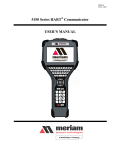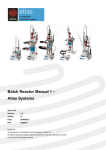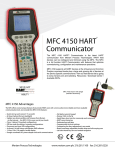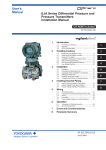Download Users Manual - Applied Measurement and Control
Transcript
Users Manual Model YHC 4100 Series HART® Communicator YHC 4100 HART® Communicator ©Yokogawa Corporation of America 2 Dart Road, Newnan, GA 30265 770-254-0400 IM 61A YHC-E-A 1st Edition: Dec. 2004 Model YHC 4100 HART® Communicator IMPORTANT NOTICE Important information on the product is contained in this manual. Read this manual carefully and completely before operating the product. For the safety of the operator and the system, a thorough understanding of this manual is necessary before commissioning, using or maintaining the product. ASSISTANCE For customer assistance please contact the local Yokogawa Representative or Yokogawa Corporation of America directly. For a geographic listing of Representatives and their contact information, visit our web site at www.us.yokogawa.com/mi . Contact Yokogawa Corporation of America directly by phone at (770) 254-0400 or by e-mail at [email protected]. Direct all assistance inquiries to the Meter & Instrument group. HART® is a registered trademark of the HART Communication Foundation. Yokogawa Corporation of America 2 Dart Rd. Newnan, GA 30265 TELEPHONE: (770) 254-0400 FAX: (770) 254-2088 E-mail: [email protected] Web Site: www.us.yokogawa.com/mi ©Yokogawa Corporation of America 2 Dart Road, Newnan, GA 30265 770-254-0400 IM 61A YHC-E-A 1st Edition: Dec. 2004 TABLE OF CONTENTS Subject Page YHC 4100 Communicator Overview .......................................................................................................... 1 Display Overview ....................................................................................................................................... 1 Header Line Symbols ........................................................................................................................... 2 Keypad Overview ....................................................................................................................................... 2 Alphanumeric Keys ............................................................................................................................... 3 Left / Right Arrow Keys ......................................................................................................................... 4 Soft Keys ............................................................................................................................................... 4 Thumb Operated Keys .......................................................................................................................... 4 General Operation...................................................................................................................................... 5 Power Options....................................................................................................................................... 5 Navigating Menus ................................................................................................................................. 5 Turning on YHC .................................................................................................................................... 6 Communicator Main Display ................................................................................................................. 6 YHC Configuration Settings .................................................................................................................. 7 Users ................................................................................................................................................ 7 Applications...................................................................................................................................... 7 EJA / EJX Accuracy Utility ............................................................................................................ 7 Lockouts........................................................................................................................................... 8 Master Lockout.............................................................................................................................. 8 PV Prompt..................................................................................................................................... 8 Unlocking a YHC ........................................................................................................................... 9 Changing the Lockout Code ......................................................................................................... 9 Clock/Timers .................................................................................................................................... 9 Others ............................................................................................................................................ 10 Model Info ................................................................................................................................. 10 Battery....................................................................................................................................... 10 Enter PC Comm. Mode............................................................................................................. 10 Battery Installation & Removal (all models) ............................................................................................. 10 External Connections ............................................................................................................................... 10 AC Adapter.......................................................................................................................................... 10 HART jacks / lead set.......................................................................................................................... 11 DB-9 Connection................................................................................................................................. 11 Hazardous Area Use................................................................................................................................ 12 Intrinsically Safe Certification.............................................................................................................. 12 HART® Communications with YHC 4100..................................................................................................13 HART Commands .................................................................................................................................13 HART Connections ...............................................................................................................................13 HART Communications.........................................................................................................................15 Initial Screens / Online Mode .......................................................................................................15 Multi-drop Poll ..............................................................................................................................15 Manual Device 0 Poll ...................................................................................................................15 Offline Menu Mode.......................................................................................................................16 List / Show DOFs ....................................................................................................................16 List / Edit Configurations .........................................................................................................16 Create Configurations .............................................................................................................17 Delete Configs / Clearing Configuration Memory ...................................................................17 Online Setup Mode ......................................................................................................................17 Communications Trouble Shooting..............................................................................................18 More Status Message ..................................................................................................................18 Save / Send Configuration Functions ..........................................................................................18 Cloning HART devices .................................................................................................................19 Saving Configurations for Multivariable HART Devices……………………..... ………………….. 19 ©Yokogawa Corporation of America 2 Dart Road, Newnan, GA 30265 770-254-0400 IM 61A YHC-E-A 1st Edition: Dec. 2004 TABLE OF CONTENTS, con’t Subject Page Documenting HART Configurations with Yokogawa DMS software.........................................................20 YHC 4100 Device Specific & Generic HART Communication..................................................................20 Using Generic Communications ..........................................................................................................20 DOF / Firmware Download Site Information .............................................................................................21 Who may use ........................................................................................................................................21 PC Requirements..................................................................................................................................21 Preparing the YHC for updating............................................................................................................21 Preparing to Download..........................................................................................................................21 Using the Download Site.......................................................................................................................21 Subscriber Options................................................................................................................................22 Installer Utility (DPC Manager)..................................................................................................................22 Returning the YHC for Repairs .................................................................................................................23 APPENDIX YHC Specifications ...............................................................................................................................24 YHC Models, Options, Ordering Information ........................................................................................25 YHC Accessories List............................................................................................................................26 Intrinsically Safe Control Document......................................................................................................27 HART Command Structure Menu Trees......................................................................................... 28-29 ©Yokogawa Corporation of America 2 Dart Road, Newnan, GA 30265 770-254-0400 IM 61A YHC-E-A 1st Edition: Dec. 2004 YHC 4100 HART COMMUNICATOR The YHC 4100 HART Communicator is the latest handheld communicator from Yokogawa Corporation of America. All HART field devices can be configured, polled, and trimmed using the YHC with HART communications. The YHC is a full function HART Communicator supporting Universal, Common Practice and Device Specific commands for commissioning, configuring and maintaining HART devices. Lanyard pins (2x) Top View AC Adaptor jack Display Up, Select, Down thumb keys Thumb keys Soft Feature keys Hand strap Alpha numeric and edit keys Battery door Side View Front View HART connection DB-9 Seria connection Bottom View Note: For Intrinsically Safe models, consult the Hazardous Area Use section of this manual for specific details on use and applicable restrictions. DISPLAY OVERVIEW The display of the YHC 4100 is a 128 x 128 pixel graphic display with backlight. Viewable area is 2.6” x 2.6” for 13 viewable message lines. The display provides three types of information: 1) header information including display titles, HART communication status indicator, SHIFT indicator, alpha or numeric entry mode indicator and battery gauge, 2) main data display section for display of YHC operating menus, HART menus, and device information, and 3) footer information defining soft key functionality. The following photo depicts the YHC Configuration menu and Soft keys: ©Yokogawa Corporation of America 2 Dart Road, Newnan, GA 30265 770-254-0400 IM 61A YHC-E-A 1st Edition: Dec. 2004 Page 1 of 29 HEADER LINE SYMBOLS KEY heart symbol indicates active HART communication u up arrow indicates SHIFT key is on # number sign indicates numeric / symbol entry is the present entry mode for all dual functions keys A letter indicates alpha entry is the present entry mode for all dual function keys battery symbol indicates YHC under battery power; filled portion indicates remaining battery life electrical plug symbol indicates the AC adapter is connected and powering the YHC BUSY BUSY text box replaces either power symbol when the microprocessor is busy executing a previously requested task. KEYPAD OVERVIEW The YHC keypad has three basic key types: single function keys, dual-function keys, and soft keys with changing definitions. Single function keys control a dedicated YHC function. Dual-function keys, through the use of the Alpha Lo or Shift keys, toggle between two separate function as needed to facilitate data entry. Soft key functions change depending on the present operating mode. Soft key definitions are displayed at the bottom of the LCD, just above their respective gray soft keys. The left hand thumb keys can be used to scroll up, scroll down, and to select menu items. ON/OFF On/Off Pressing the ON/OFF key powers up or turns off the YHC. As the unit powers up, an internal diagnostic check is performed. Any abnormalities are posted on the display. The unit will briefly display the YHC model number and then check for a HART device with address of zero. If a device with zero address is found, the YHC immediately goes into online status and displays information about the device. If no device is found, the YHC enters the “Communicator” screen. To turn the YHC ©Yokogawa Corporation of America 2 Dart Road, Newnan, GA 30265 770-254-0400 IM 61A YHC-E-A 1st Edition: Dec. 2004 Page 2 of 29 off, press and hold the ON/OFF key for approximately .5 seconds. Unit will power down provided a critical HART operation is not in process. QUICK MENU Home QUICK MENU Quick Menu The Quick Menu key initiates HART communications and then displays ten (10) HART menu choices for the connected device. These menus are used to short cut the traditional HART menus to enable the user to arrive quickly at the desired functions. Typical Quick Menu options include: Main Menu, Config Menu, Rerange, Basic Info, Construction Materials, Display, Sensors, Signal Conditioning, Self Test. Quick Menu is disabled while critical HART operations are in process. Home The key sequence SHIFT, Home returns the user to the initial or “home” HART menu for the connected device. The Home function is disabled while critical HART operations are in process. Document This key provides rapid access to HART communication Save/Send Configs, List/Edit Configs, and Create Configs functions for all YHC models. For Documenting models this key also provides documenting functions used with the Yokogawa Device Management System software. Access to this key is disabled while critical HART communications are in process. Display Contrast This key allows the user to adjust the contrast of the LCD display for ambient lighting and user preferences at any time and in any operating mode. Pressing and holding this key cycles through all available contrast settings. If the display is faded or blacked out, simply depress the key until the display returns to an acceptable level. After adjusting Display Contrast, wait at least five (5) seconds before turning unit off to insure storage of new contrast setting. Ambient temperature compensation for display contrast is standard on the YHC 4100. Back Light This key provides a backlight to illuminate the display in poor light conditions. Battery life is impacted by long-term use of the backlight feature. An automatic shut off timer is available to the user under the Main Menu’s Cfg soft key. 2B L SHIFT ALPHA LOCK Alphanumeric / Symbol Entry The alphanumeric keys are the method of entering data into the YHC. Each YHC display has a default alpha or numeric / symbol entry mode based on the most likely used mode for the display’s function. This reduces user workload to a minimum. Pressing the ALPHA LOCK key activates the other entry mode at the user’s convenience. Pressing the SHIFT key converts the next key stroke to the inactive entry mode and then automatically reverts back to the default mode. The letter “A” in the display header line indicates the alpha input default is active while a # sign in the display header indicates the numeric / symbol input is the default. SHIFT The SHIFT key is used to activate the secondary functions of the YHC’s dual-function keys for the next keystroke only. When the SHIFT key is active, an up arrow uis displayed at the top of the display to the left of the battery gauge (or AC wall plug) symbol. SHIFT is also used to toggle the Page Up and Page Down soft key functions while viewing lists of information (installed DOFs, stored configs, etc…). Alpha Lock This key changes the keypads dual function keys from numeric/symbol entry mode to alpha character entry mode and back. The present entry mode is indicated in the display header line next to the power supply indicator on the upper right of the screen. The letter “A” in header line indicates active alpha entry while a # sign in the display header indicates that numeric / symbol entry is active. ©Yokogawa Corporation of America 2 Dart Road, Newnan, GA 30265 770-254-0400 IM 61A YHC-E-A 1st Edition: Dec. 2004 Page 3 of 29 Left / Right Arrow keys These keys support cursor movement forward and backward for text / numeric editing needs. The default edit mode is “overwrite.” For navigating functions, the left arrow emulates the Back soft key and the right arrow emulates the Select soft key. DEL INS DEL Delete This editing key will delete the character located above the cursor in a text / numeric string. Insert The Insert text edit function is activated by pressing the Shift, INS key sequence. Once activated, the next alpha or numeric / symbol keystroke will be inserted into the open text field. The “overwrite” default mode is restored upon completion of the insert operation. Soft Keys (unlabeled) The four gray keys located immediately below the display are Soft Keys. The specific functions of these keys change depending on the operating mode of the YHC. Present definitions are displayed at the bottom of the YHC display. The following are examples or Soft Key definitions and their uses: Up – moves indicator arrow up one line in a menu list Down – moves indicator arrow down one line in a menu list Select – selects the indicated menu item for further action Chng – selects the indicated menu item for change Cfg – provides access to YHC configuration settings (Users, Applications, Lockouts, Clock/Timer, Other [Model Info, Battery type, Enter PC Comm Mode]) Back – returns to prior display Inc – Increment the value shown above the cursor Dec – Decrement the value shown above the cursor Next / Prev – these keys move to Next or Previous item within the list function accessed. Next and Prev are for navigation only. Done – Ends data entry session and proceeds with the selected operation Edit – activate edit function for displayed parameter Abrt – aborts present operation without affecting prior settings or values Save – saves the present value Store – stores the present value Yes – affirmative response to question presented No – negative response to question presented Trim – executes the trim function called for by the HART menu option selected PgUp – changes display to previous page PgDn – changes display information to next page Thumb operated keys Up, Select, and Down side keys provide a convenient alternate methods of menu navigation. Use these in addition to Soft keys and numbered HART menu lines to make menu navigation fast and easy. = Up = Prev = Select, Edit = Down = Next Do not use these keys when the ©Yokogawa Corporation of America 2 Dart Road, Newnan, GA 30265 770-254-0400 BUSY symbol is displayed. IM 61A YHC-E-A 1st Edition: Dec. 2004 Page 4 of 29 GENERAL OPERATION Power options The YHC 4100 can be powered for portable operation by two each 9-volt alkaline, Lithium or NiMH batteries. Alkaline batteries are standard with the YHC shipment. Yokogawa offers NiMH batteries and charger cradles (external charge only) as an option. For bench top operations and download operations, an AC adapter (P/N A36742) is recommended. Located in the upper right corner of the display, this icon displays the remaining battery power. Fresh batteries produce a full black cell body. As the power drains, the black segment retreats indicating remaining power. When the YHC is used with the optional AC adapter (P/N A36742), the battery circuit is bypassed and a wall plug icon replaces the battery icon on the display header. The AC adapter jack is located on the left side of the YHC. NOTE: Power icons may temporarily disappear during certain HART Communication operations Navigating Menus on the YHC display Several methods of navigating through the YHC menus are available to the user for maximum convenience and utility. 1. Soft keys: Use Up and Down Soft Keys to move cursor arrow to the desired menu option. Then use the Select soft key to accept the indicated choice. Soft key navigating tools are found throughout the Communicator displays and HART communication displays. 2. Side keys: Up, Down and Select keys are also provided on the left hand side of the YHC. These keys are thumb operated and provide a convenient alternative to the Soft Key navigation buttons. Side key functionality is not always available in the HART communication displays. 3. Multi-page lists: Multi-page lists have a and/or symbol along the right hand side of the display indicating the existence of information on the previous or next page(s). Several pages of information may need to be viewed when reviewing lists of installed DOFs, stored configuration files or finding a specific device in Offline Mode to create a configuration for. While in these list areas, pressing the SHIFT key changes soft key definitions Select and Back to PgUp and PgDn, respectively. To quickly advance to the next page of a list, press SHIFT and then the PgDn soft key. To retreat to the prior page, press SHIFT and then PgUp. After SHIFT is pressed the PgUp and PgDn soft keys remain active until the Up or Down soft key is used or until SHIFT is pressed again. 4. Numbered HART menus: All HART displays have numbered menu lines to give fast access directly to the desired menu line. Communicator displays also have numbered menus. Press the number key to access the desired menu item. 5. HART menu HOME key: To quickly retreat from any location in the HART menu to the initial HART menu screen for a device, press the SHIFT, HOME key sequence. This will return the display to the initial HART screen. The Home function will be disallowed if a critical HART task is in process. 6. Left / Right Arrow keys: Emulate Back and Select soft keys, respectively ©Yokogawa Corporation of America 2 Dart Road, Newnan, GA 30265 770-254-0400 IM 61A YHC-E-A 1st Edition: Dec. 2004 Page 5 of 29 Turning on the YHC Use the dedicated ON/OFF key to power up the YHC. A brief diagnostic runs while the Yokogawa Corporation of America logo, YHC model number, and YHC firmware version is displayed. A message is displayed indicating the YHC is scanning for a HART device at address zero. The following scenarios are possible. 1. If the YHC is connected to a HART device with address zero (and there is sufficient loop resistance), the YHC immediately establishes HART communication with the device. A display similar to the example at right appears. The numbered menus and Soft Keys are then used to commission, re-configure, or maintain the connected device. Main Menu # 3051 : PT-1012D 1 Device setup 2 Pres: 0.01 inH2O 3 AO: 4.001 mA 4 LRV: 0.00 inH2O 5 URV: 250.00 inH2O Up 2. If no HART device is connected, a HART device with address ≠ 0 is connected, or a connected device is not found due to wiring or loop resistance problem, the YHC will enter the Communicator display depicted at right. 2.1 Select Online Setup once a HART device is connected or once the wiring problem is resolved. A proper connection will be indicated when line two changes to “Device 0 *Online*” and connection is made. Down Select Communicator Back # 1 Online Setup 2 Offline Menu Device 0 Not Found Up Down Select Cfg 2.2 Select Online Setup if properly connected HART device is setup for Multi-drop loop or Burst Mode operation (device address ≠ 0). The YHC will immediately initiate a multi-drop poll to identify all non-zero addresses on the loop. Communicator Main Display The Communicator main display provides access to Online Setup, Offline Menu and to YHC configuration settings via the Cfg Soft Key. 1. Online Setup is described above in Turning On the YHC. 2. Offline Menu is selected to provide access to Offline Utilities such as List / Show DOFs, List / Edit Configurations, and Create Configurations. The number of DOFs installed (HART device profiles) and the number of device Configurations stored is also available on Offline Utilities screen. Communicator # 1 Online Setup 2 Offline Menu Device 0 Not Found Up Down Select Cfg 3. Cfg Soft Key is selected to configure YHC settings and view YHC information ©Yokogawa Corporation of America 2 Dart Road, Newnan, GA 30265 770-254-0400 IM 61A YHC-E-A 1st Edition: Dec. 2004 Page 6 of 29 YHC Configuration Settings Users (active only on 21CFR Part 11 capable YHCs) Displays the approved Users for Configuration changes and Calibrations – See the 21CFR Part 11 User’s Manual for more information. Applications Allows user to select special applications available on the YHC. Follow the on-screen prompts and directions to utilize these Applications. Configuration Current Settings 1 Users 2 Applications 3 Lockouts 4 Clock/Timers 5 Other # Up Back Down Chng EJA / EJX Accuracy Utility This program is designed to aid in the calibration of the Yokogawa EJA / EJX Pressure Transmitter series. The program will calculate the maximum error based on design accuracy of the EJA / EJX and the pressure module used when performing a calibration with the YPC. Get HART Data: If the EJA / EJX has HART Communications, the program will automatically read all necessary information needed to perform the calculations. If the EJA / EJX does not have HART Communications an “EJA not found” error will be displayed. Data can be input manually into the program for non-HART units. EJA Model: This data can be obtained automatically by selecting “Get HART Data” or manually input by selecting the Chng soft key. Pres Unit: The pressure units can be obtained automatically by selecting “Get HART Data” or manually input by selecting the Chng soft key. Zero (LRV): The Low Range Value can be obtained automatically by selecting “Get HART Data” or manually input by selecting the Chng soft key. Span (HRV): The High Range Value can be obtained automatically by selecting “Get HART Data” or manually input by selecting the Chng soft key. Module: Not applicable on the YHC. Calculate: Calculates data and goes to the results screen. If a pressure module was selected, the message “Accuracy is dependent on the span of the pressure module used” is displayed for 3 seconds. Accuracy %: This is the maximum error of the calibration of the EJA / EJX in % of span. If a pressure module was selected, then the accuracy of the pressure module is included in the calculation to determine overall error. If “None” is selected then the design accuracy of the EJA / EJX is used to calculate the overall error. ©Yokogawa Corporation of America 2 Dart Road, Newnan, GA 30265 770-254-0400 IM 61A YHC-E-A 1st Edition: Dec. 2004 Page 7 of 29 Accuracy mA: This is the maximum error of the calibration of the unit in mA. The design accuracy of the EJA / EJX is used to calculate the overall error. Min Span: Displays the minimum span of the EJA / EJX unit. Max Span: Displays the maximum span of the EJA / EJX unit. LRL: Displays the lower Range Limit of the EJA / EJX unit. URL: Displays the upper Range Limit of the EJA / EJX unit. Lockouts The YHC HART Communicator can be programmed to lock out all adjustable functions or only certain functions that a supervisor may wish to control. These are Enabled or Disabled individually on the Lockout Details screen shown at right. To access, select the Cfg soft key from the Communicator Main Screen, then the Lockouts option, and finally the View Details option. “Disable” on this screen means the particular menu function will not be locked out and “Enabled” means the particular menu function will be locked out once the Master Lockout is Enabled. Move the cursor to the desired line and use the Chng soft key to change the status of each line. Configuration Lockout Details All : Setting : DOFs : Configs : Firmware : PV Prompt : Up Down # Disable Disable Disable Disable Disable Disable Chng Back Lockout Details Screen All - all YHC functions listed on Lockout Details screen Settings - clock, timers, battery type, PC comm mode DOFs - the ability to install new DOFs Configs - the ability to edit saved configurations in Offline mode Firmware - the ability to install new firmware PV Prompt – the ability to lock out the PV Prompt (see the “Saving Configurations for Multivariable HART Devices PV Prompt” section of this manual for more details) Master Lockout Once the Lockout Detail status (Disable or Enabled) is correct, select the Back soft key to arrive at the Current Settings screen shown at right. To activate the lockout features previously selected on the Lockout Details screen, move the cursor to the Lockout option line and press the Chng soft key. If there is an active Lockout code, then the display will prompt the user to enter the code. Use the Inc, Dec, Next, and Store soft keys to enter and store a 3-digit code. If no Lockout code is active, then using the Chng soft key to change the status to Enable will cause the unit to request a 3-digit lockout code of the user’s choosing. Once the code is stored and power is cycled, all Lockout Details selected are locked out from use. Configuration Current Settings: 1 Lockout: 2 PV Prompt: 3 View Details Up Down # Disable Disable Chng Back Master Lockout Enable / Disable Screen PV Prompt PV Prompt option on this display allows user to “Disable” the PV Prompt question for multivariable HART devices or to “Enable” the display of this question and its capabilities. The question reads: “Multivariable device, allow PV changes? Yes / No” See the “Saving Configurations for Multivariable HART Devices” section of this manual for more details. ©Yokogawa Corporation of America 2 Dart Road, Newnan, GA 30265 770-254-0400 IM 61A YHC-E-A 1st Edition: Dec. 2004 Page 8 of 29 Unlocking a YHC To perform any changes to the YHC’s setting when lockout is engaged the user will be prompted to input the lockout code prior to allowing any changes. Use the Increment, Decrement and Next Soft Keys to input a lockout code value. Alternatively you may use the green keys for Increment and Decrement functions. When you are satisfied with the lockout code value, press Store to unlock the YHC. Changing the Lockout Code To change the lockout code, disable the Master Lockout option on the Current Settings screen. You will be prompted for the old code before any change is made. Press the Chng soft key until Enable is displayed again and then press the Chng soft key one more time. The unit will prompt for entry of a new 3-digit code. Press Store soft key and cycle power to complete. Important note: All units are shipped with the PV Prompt locked out with a lockout code of 3-2-1. See the “Saving Configurations for Multivariable HART Devices” section of this manual for more information on PV Prompt. Important note: After the lockout code is entered, the user must cycle the power to activate the lockout mechanism! BE SURE TO SAVE THIS CODE IN A SAFE PLACE IN THE EVENT YOU FORGET THE NUMBER. ACCESS TO LOCKED-OUT FEATURES WILL BE DENIED WITHOUT THE PROPER CODE. Important note: Check Lockout status after each firmware update install session to ensure desired status has been maintained. Clock/Timers The Clock Edit option allows the user to correct the date and time of the YHC’s internal clock. To select the Clock Edit feature, select the Clock Edit option and press Chng. Choose a clock or date option to adjust by selecting the desired menu line. Press Chng to choose that option. Enter the correct value using the numeric keypad and text edit key if needed. When complete, press Done. You will be asked if you wish to save the new data. Press Yes to accept the new value. Pressing No will take you back to the Clock Edit without making any changes to the YHC clock. Configuration # Current Settings: 1 Clock Edit 2 Backlight: 1 min 3 Off Timer: 1 min Up Down Chng Back Clock/Timers Screen The Backlight Timer can be used to conserve battery life by setting the timer to shut off after a period of keypad inactivity. To change the Backlight Timer on the unit, select the Backlight option and press Chng until the desired time period is displayed. The Backlight Timer can be disabled or set to shut off after time periods from 1 minute up to 30 minutes. The Off Timer can be used to conserve battery life by setting the timer to shut off after a period of keypad inactivity. To change the Off Timer on the unit, select the Off Timer option and press Chng until the desired time period is displayed. The Off Timer can be disabled or set to shut off after time periods from 1 minute up to 2 hours. NOTE: The Backlight Timer is disabled when the optional AC Adapter (P/N A36742) is powering the YHC. NOTE: The Off Timer is disabled when the optional AC Adapter (P/N A36742) is powering the YHC. NOTE: When replacing the batteries, the date and time will remain active. Date & time information is continuously powered by an internal, 10-year life back-up battery. This battery is not serviceable by the user. ©Yokogawa Corporation of America 2 Dart Road, Newnan, GA 30265 770-254-0400 IM 61A YHC-E-A 1st Edition: Dec. 2004 Page 9 of 29 Other This menu option provides access to Model Information, Battery type setup and PC Comm Mode setup Model Info: This option gives all the information about the model. It shows the model name, serial number, firmware version, and date of last firmware update. It also displays information about number of DOFs installed, number of configuration stored, and percentage of free memory for each. Configuration # Current Settings: 1 Model Info 2 Battery: Alkaline 3 Off Timer: 1 min Up Down Chng Back Battery: “Other” Menu Screen This option allows the user to set the battery type being used. Alkaline, NiMH and Lithium batteries all have different discharge curves. Selecting the correct battery type provides the most accurate battery gauge icon performance. To change the battery type, select the menu option line until the correct type is shown. Enter PC Comm Mode When the YHC is connected to a PC for updates via MFx Installer (see MFx Installer section in this manual), a DB-9 serial cable is used. Occasionally a DB-9 Serial cable is encountered that does not have a DTR line. The DTR line is important to the update process because it is used to initiate and confirm communication between the two machines. If a DB-9 cable without a DTR line is used, the YHC must be manually placed in the Enter PC Comm. Mode. Go to the YHC Main display and select YHC. Scroll down to the Enter PC Comm. Mode menu option and press Select. Proceed with update and cycle YHC power when the update is complete. It is recommended to use fresh batteries or an AC adaptor during update procedures. This mode will automatically time-out after approx. 2 minutes of inactivity and return to the main display. Battery Installation & Removal – all YHC models The YHC monitors battery condition and displays a “REPLACE BATTERY” notice when the batteries get low. The YHC will function for a short period of time after the notice is posted. To install or remove the batteries, remove the soft case or protective boot and turn the YHC face down on a work surface. Use a flat screwdriver to loosen the captive screw holding the battery door closed and remove door. Replace batteries and make sure all connections are firmly secured. Replace door, tighten screw and replace the soft case or boot. Note: Replace both 9-volt batteries at once with all alkaline, all lithium or all NiMH cells. Do not mix alkaline, lithium or NiMH batteries with each other or with other battery types. Battery replacement is recommended when the “Replace Batteries” notice is posted on the display; however, the YHC will function for a time after the notice is posted. Note: For Intrinsically Safe models, replace batteries only in Non-Hazardous Areas. Replace batteries with approved types only. See the Intrinsic Safety Control Document in the Appendix of this manual for approved battery details. External Connections to YHC 1. AC Adapter – The YHC 4100 can be powered by external AC Adapter connected to the jack located on the left side of the YHC. P/N A36742 bypasses the battery circuit to power the unit. The battery symbol in the display header is replaced by a wall plug symbol. WARNING: Serious injury or death may result from explosions. Do not make connection to the AC adapter jack in a hazardous area. Use the AC adapter only in non-hazardous areas. ©Yokogawa Corporation of America 2 Dart Road, Newnan, GA 30265 770-254-0400 IM 61A YHC-E-A 1st Edition: Dec. 2004 Page 10 of 29 2. HART jacks / lead set – All YHC models are equipped with a standard size banana jack on 0.75” center. The lead set supplied with the YHC has a standard banana plug on one end and mini-grabbers on the other for convenient connections. Note: For Intrinsically Safe models, verify the instruments in the loop are installed in accordance with intrinsically safe field wiring practices before making connection from the field device to the HART jack. See Hazardous Area Use Section of this manual for Intrinsically Safe guidelines / restrictions. 3. DB-9 Connection Port – All YHC models are equipped with a standard DB-9 connection for RS-232 communications located on the YHC’s bottom end. The DB-9 provides the hardware interface to facilitate download / upload operations from a host PC. This connection port facilitates download of YHC firmware improvements, HART® Device Object Files (DOFs) and documenting operations (Documenting options pending). All YHC upgrades are available via the Yokogawa Corporation of America Download Site accessible from www.us.yokogawa.com/mi/ypcyhc.com. The YHC will not need to be returned to Yokogawa for firmware updates or for the addition of DOF files. Note: Do not use the DB-9 connection port in Hazardous Areas. Use in non-hazardous areas only. See Intrinsic Safety Control Document in the Appendix for more details on I. S. units. ©Yokogawa Corporation of America 2 Dart Road, Newnan, GA 30265 770-254-0400 IM 61A YHC-E-A 1st Edition: Dec. 2004 Page 11 of 29 HAZARDOUS AREA USE Intrinsically Safe Certification The HART Communicator is available with Intrinsically Safe Certification from MET Laboratories. MET Laboratories is a Nationally Recognized Test Lab (NRTL). The Communicator is certified by MET Laboratories to comply with standards CSA C22.2 No.1010.1, C22.2 No. 157-92 and UL913 Fifth Edition Rev 2/21/97 for Class I, Division I, Groups A, B, C, and D, T5 hazardous areas. Refer to the Intrinsically Safe Control Document shipped with each unit for more information. An uncontrolled copy of the I.S. Control Document is included in the Appendix of this User’s Manual for reference only. The following table identifies model numbers and areas of acceptable use. Model Number YHC 4100-01-x-00-x-xx-x-xx-x YHC 4100-01-x-01-x-xx-x-xx-x Non-hazardous Hazardous Area Area √ NO √ √ Intrinsically Safe certification can be identified by model number (see table above or the Intrinsically Safe Control Document in the Appendix) or by a special label affixed to the unit. WARNING: Serious injury or death may result from explosions. Do not make connection to the DB – 9 connection port or to the AC adapter jack while in a hazardous area. WARNING: Serious injury or death may result from explosions. Before making electrical connections to an Intrinsically Safe unit at the HART jacks, verify the instruments in the loop are installed in accordance with intrinsically safe field wiring practices. Note: Restrictions apply to the use of Intrinsically Safe units in hazardous areas. Refer to the Intrinsically Safe Control Document in the Appendix for details. The manufacturer reserves the right to revise the Control Document without notice. Contact Yokogawa Corporation of America (phone (770) 253-7000) for the current Intrinsically Safe Control Document. For Intrinsically Safe units, consult the Hazardous Area Use section of this manual for restrictions, for special instructions in use, and for electrical connections. ©Yokogawa Corporation of America 2 Dart Road, Newnan, GA 30265 770-254-0400 IM 61A YHC-E-A 1st Edition: Dec. 2004 Page 12 of 29 HART® Communications with the YHC 4100 Overview The YHC 4100 HART communicator provides device specific HART communication functions that allow the user to poll, configure and maintain supported HART field device. The YHC 4100 uses Universal, Common Practice and Device Specific commands to facilitate communication with a HART field device. Use the YHC to commission devices, operational re-configuration needs, or maintain devices through analog and sensor trim adjustments and many other features. The YHC 4100 will communicate with any HART device through Universal and Common Practice Commands using the standard Generic DOF (Device Object File) but must have the DOF for a specific HART device installed before it can execute Device Specific Commands. Consult the large and growing list of available DOFs at www.us.yokogawa.com/mi/ypcyhc.com for an up to date list of HART devices with device specific support. The list is found under “Available DOFs” in the Download Center. When HART device support for new devices becomes available, the YHC can be easily field updated via Internet downloads. HART Commands Three HART command types are used by the YHC 4100 to communicate with HART field devices. First, Universal Commands are primarily used to identify a field device by its model number and tag number and to read process data from the device. This communication is referred to as “polling”. The YHC 4100 can poll any Hart Device. Second, Common Practice Commands are used for calibration and maintenance functions that are common to many devices. An example of this would be trims or adjustments for the devices’ analog outputs. Third, Device Specific Commands are used to handle functions that are unique to a particular device or manufacturer. Examples of these commands include sensor zero, sensor trim, calibration curve characterization, density inputs required for calculations made by the HART device or other configuration functions unique to the specific device. HART Connections HART connections are made using two standard banana jacks (3/4” center) located at the top end of the YHC 4100. Refer to the following diagram. Polarity is not a concern for HART connections so both jack collars are black. A HART lead kit (P/N A36744) complete with mini-grabber connections and a 250 Ω load resistor with each model YHC 4100. YHC 4100 with HART® HART® connections are standard banana jacks (3/4” center) For low load loops (less than 250 Ω), a 250 Ω resistor will need to be added to the loop to insure reliable HART communications. Yokogawa supplies a 250 Ω load resistor in the form of a standard adaptor (P/N A36821). Refer to the following diagram for connection details. ©Yokogawa Corporation of America 2 Dart Road, Newnan, GA 30265 770-254-0400 IM 61A YHC-E-A 1st Edition: Dec. 2004 Page 13 of 29 When connecting the YHC 4100 to a loop with a resistive load greater than 250 Ωs, the HART jacks may be connected across the loop + and – or to the HART device communication terminals. Refer to the following diagram for connecting across the loop + and -. Connecting to the YHC communication terminals ©Yokogawa Corporation of America 2 Dart Road, Newnan, GA 30265 770-254-0400 IM 61A YHC-E-A 1st Edition: Dec. 2004 Page 14 of 29 HART® Communications Upon power up the YHC automatically detects if a field device is connect and attempts to establish HART communications. When a device with address zero is found, the YHC provides feedback to the user and starts the initial HART display for the connected device. See an example of Online Mode below. Main Menu # 3051 : PT-1012D 1 Device setup 2 Pres: 0.01 inH2O 3 AO: 4.001 mA 4 LRV: 0.00 inH2O 5 URV: 250.00 inH2O Up Down Select Back Online HART Screen When no device connection is detected or a device with non-zero (Multi-drop or Burst Mode) address is found, the message Device 0 Not Found is displayed and the YHC enters the YHC Main navigation screen. The YHC Main screen allows the user to launch a multi-drop poll to find all devices with non-zero addresses on the loop, to manually start an Online poll, or to enter Offline Mode. Communicator 1 2 # Online Setup Offline Menu Communicator Multidrop Polling… # Communicator 1 2 Device 0: Not Found # Online Setup Offline Menu Device 0: *On-line* Scanning Address # Up Down Select YHC YHC Main Navigation Screen No device or Non-zero address found Stop Multi-drop Polling Screen Multi-drop & Burst Mode Support Up Down Select Cfg YHC Main Navigation Screen Manually launch polling on Device 0 Multi-drop Poll To initiate a Multi-drop Poll, select the Online Setup option from the YHC Main screen when the Device 0 Not Found message is displayed. This function polls for all non-zero addresses (1 – 15). Located addresses are listed on the display as the remaining addresses are checked. When polling is complete, or upon pressing Stop after the address of interest is found, use the soft key controls to select the address of interest. The initial HART menu for the device selected will then be displayed for use. Manual Launch of Device 0 Poll When the message Device 0 *On-line* is displayed on the YHC Main navigation screen, selecting Online Setup will launch HART communication with the device. The message indicates that a HART device with address 0 has been detected at the HART connection and the YHC is standing by to initiate communications. The Device 0 *On-line* message is shown 1) if a physical connection is made to a HART device after the YHC power is turned on or 2) if the user exits from a HART communication session using the soft key controls provided. ©Yokogawa Corporation of America 2 Dart Road, Newnan, GA 30265 770-254-0400 IM 61A YHC-E-A 1st Edition: Dec. 2004 Page 15 of 29 Offline Menu Mode The Offline Menu gives the user access to lists and functions that can be viewed or performed in Offline Mode. The user can review the YHC’s DOF list, review stored device configurations, or create HART configurations. Stored configurations can also be edited and then applied later to a connected HART device. When the Offline Menu is selected from the YHC Main navigation screen, the display to the right is shown. Offline # Utilities 1 List/Show DOFs 2 List/Edit Configs 3 Create Configs 4 Delete All Configs DOFs Installed: Configs Stored: Up Down 204 58 Select Back Hart Offline Menu Screen List / Show DOFs: Provides a list of installed DOFs (Device Object Files) used by the YHC to communicate with HART devices. Lists can be view by Manufacturer, by Device Name or by stepping through all Devices one at a time. Use the soft key controls to move through the list. Pressing the SHIFT key changes soft key definitions Down and Up to PgUp and PgDn. To quickly advance to the next page of a list, press SHIFT and then the PgDn soft key. To retreat to the prior page, press SHIFT and then PgUp. Once engaged, the PgUp and PgDn soft keys remain active until the Up or Down soft keys or SHIFT is pressed again. List / Edit Configs: This screen lists all stored HART configurations by Tag Number. For detailed information on a stored configuration, move the cursor to the desired tag number and press the Select soft key. The Config Detail screen (see example below, right) provides information to help the user confirm the identity, origin, and save date/time of the configuration. Pressing Select again opens the configuration for review or offline editing needs. Any configuration in the list can be sent to another HART device of the same manufacture and model number. This feature enables fast commissioning of replacement devices, cloning of existing systems, or re-configuring for changes in process conditions or batch runs. The editing function can be locked out. See the Lockout Section of this manual for more information. Offline List/Edit Configs PT-105A PT-105B DPT-201C TT-312A TT-312A FE-201 FE-201 PT-6174 # Up Back Down Select Offline List / Edit Configs Screen New configurations saved to this list are added to the bottom of the List / Edit Config list. If multiple entries for one device are shown, the most recently saved configuration is always shown at the bottom of the list. Entries in the List / Edit Config list may have been saved or created from various sources. Possible sources include the save command from a connected HART device, created in the YHC using the Create Configs function, copied from another configuration and renamed, or created by editing an existing file. A YHC with Documenting option also lists configurations downloaded from the available Device Management System (see www.us.yokogawa.com/mi/ypcyhc.com/dm_solns.htm for more information). Tag numbers, date / time of save, type of configuration stored, and other information are displayed under List/Edit Configs. Configuration types are: Complete Config Default Config Edit Vars Only Offline List/Edit Configs Tag: PT-105A # Device ID 1365 PV: Pressure Yokogawa EJA Complete Config Uses DOF 3704020B 51 Variables 12/18/03 4:58 PM Copy Del Select Back = saved from connected device in Online mode, or a complete config that was downloaded from DMS Offline List / Edit = created by YHC in Offline mode, or created in DMS Configs Detail Screen and downloaded to YHC = created by editing an existing configuration and includes only the edited parameters ©Yokogawa Corporation of America 2 Dart Road, Newnan, GA 30265 770-254-0400 IM 61A YHC-E-A 1st Edition: Dec. 2004 Page 16 of 29 Create Configs: The Create Configs function allows the user to configure a HART device file in Offline Mode for sending to the intended device later when connected in the Online Mode. Use the soft key controls to move through the list and select the device model number required. The menus prompt the user to make the necessary configuration selections, tag the file for later retrieval and use, and edit configuration lines as required. This function can be locked out. See the Lockout Section of this manual for more information. Delete All Configs: The Delete All Configs function clears all configurations from memory (including active and hidden configs). When this menu option is selected, the YHC will ask “Delete ALL Configs… ARE YOU SURE???” Select Yes to clear all stored configurations from memory. Delete Configs / Clearing Configuration Memory: Individual stored Configurations may be deleted with YHC Del soft key functions (see example at right). A delete confirmation screen is provided to prevent unintended deletions. The Del key only hides the record from the YHC screen; it does not clear memory space. The editing function can be locked out. See the Lockout Section of this manual for more information. To clear all configurations from memory, enter the HART Offline Menu Screen and select the Delete All Configs option. The YHC will ask “Delete ALL Configs… ARE YOU SURE???” Select Yes to clear all stored configurations from memory. Offline List/Edit Configs Tag: PT-105A # Device ID 1365 PV: Pressure Yokogawa EJA Complete Config Uses DOF 3704020B 51 Variables 12/18/03 4:58 PM Copy Del Select Back Delete Individual Configs Online Setup Mode Config Menu is the normal HART communication mode for the YHC. This mode enables communication with HART field devices at the Universal, Common Practice and Device Specific Command levels for full device setup and functionality. Menus displayed for the connected device follow the HART device manufacturer’s menu structure for the connected device. Consult the device manual for menu structure details. YHC features two unique online features for added convenience to the user. 1. Live HART connection monitor: YHC display lets you know from the Main navigation screen when a device is * On-line * and ready for communication. Config Menu # EJA: PT-1012D 1 Process variables 2 Sensors 3 Analog Trim 4 Basic setup 5 Display 6 Hart Output 7 Write Protect 8 Diagnostics 9 Save/Send 0 Review/Edit Up Down Select Back Online Device Setup Screen 2. Review/Edit: this menu option allows the user to review configurations line-by-line. YHC supports editing of the configuration once the line of interest is located. ©Yokogawa Corporation of America 2 Dart Road, Newnan, GA 30265 770-254-0400 IM 61A YHC-E-A 1st Edition: Dec. 2004 Page 17 of 29 Communications Trouble Shooting If an operating HART device is connected to the YHC but the “Device 0 Not Found” notification is received, a Multidrop Poll may be executed to determine if the connected device has a non-zero address. Select Online Setup from the YHC Main navigation screen to initiate the multi-drop poll. If the “No Devices Found” message is received, then the loop connections to the YHC should be carefully checked. If an operating HART device with address zero (0) is connected to the YHC but the “Device 0 Not Found” notification is received, the loop connections to the YHC should be carefully checked. Make sure all connections are correct and secure. Check for shorts, open circuits and multiple grounds. Determine if the loop resistance is greater than 250Ω and less than 1100Ωs. If less than 250 Ω then use the supplied 250 Ω load resistor in series with the loop (see diagram HART Connections section). If communication is still not established, check the List / Show DOFs menu under Offline Menu. Check the list for the presence of the “Generic” DOF under the manufacturer name “Meriam.” If “Generic” is found, then HART communication is possible when the device is properly wired and connected to the YHC (see connection troubleshooting details above). When the message “Generic” is displayed after connecting to a HART device there are two possible causes: 1) No device specific DOF for that device is currently installed in YHC memory. Check the Download Site for availability of the DOF needed by clicking on the Download Site button at www.us.yokogawa.com/mi/ypcyhc.com and entering the User Name and Password provided with YHC shipment. For download instructions, see the DOF Download Site Information section of this manual. 2) The DOF “Device Library” is missing or has become corrupted. Without a matching DOF, the YHC may not recognize a connected device. Check the List / Show DOFs menu option of Offline Menu. More Status Message HART device events (diagnostic flags) cause the YHC to display a “More Status Message” at the bottom of the display. This message is a notice to the user that one or more diagnostic warnings are available in the Review Status menu option of the connected device. Upon receipt of this message, enter the HART mode and select Detailed Setup / Diagnostics – Service / Test – Status / View Status to retrieve the diagnostic information. Save / Send Configuration Functions HART device configurations may be saved to YHC memory or sent from YHC memory to a HART device in all YHC model numbers. These functions are useful for cloning a device configuration for use in another transmitter of the same configuration, for recording as-found and as-left configurations for later review, for returning HART devices to previously used configurations, etc… The Save / Send function may be accessed in one of two ways: 1. Press the Document key on the YHC for the screen shown at right. Then select the “Save/Send Configs” menu option to launch a HART communication poll and use the Save / Send options. 2. Use the Save / Send menu option within the HART device’s standard menu. The YHC would be in Online mode in this case. Save / Send is normally found under the “Device Setup” menu option on the initial HART display for the device. Document # Utilities 1 Save/Send Configs 2 List/Edit Configs 3 Create Configs 4 Delete All Configs Configs Stored: Up Down 98 Select Back Document Key Menu Screen ©Yokogawa Corporation of America 2 Dart Road, Newnan, GA 30265 770-254-0400 IM 61A YHC-E-A 1st Edition: Dec. 2004 Page 18 of 29 Cloning HART devices Cloning an existing HART device configuration can be very useful for configuring other devices of the same type. The YHC provides two options suitable for cloning. Copy configuration and send to new device Connect to the HART device of interest and select the Save option to save a copy of the configuration. Connect to the new device of same manufacturer and model and select the Send option. The screen will show all saved configurations by tag number. Move the cursor to the desired configuration and press the Select soft key. Verify the configuration is the one desired by reviewing the displayed details. When satisfied press the Select soft key to send this configuration to the connected device. Now use normal HART communication menus to replace the old tag number sent with the new tag number and to correct any other parameter(s) necessary. Make a copy of a previously saved device configuration Go to the Communicator Main display and select the Offline Menu. Select List Edit Configs to view the list of stored configurations, move cursor to desired configuration and press the Select soft key. Verify the configuration is the one desired by reviewing the displayed details. When satisfied, press the Copy soft key. A complete configuration copy (all variables) will be made and a prompt to “Enter New Tagname” will be displayed. Enter the new tag number here to name the new configuration file. Immediately press the Select soft key and edit the Tag parameter to the desired tag number and any of the other parameters as necessary. Select the Back soft key to complete the operation. The cloned configuration is now ready to send to the new device. Saving Configurations for Multivariable HART Device Multivariable HART devices permit the user to select one Primary Variable (PV) from its device variables list and assign the analog output to the selected PV. These device variables may be measured or calculated by the device (e.g. mass flow, density, temperature, viscosity, etc… for a coriolis mass flow meter). For some users saving only the PV’s HART parameters may be satisfactory. However, it may be useful in multivariable applications to save the parameters of the secondary, tertiary, and other variables in addition to the PV parameters. YHC allows the user to save only the PV parameters or to save the parameters of all variables by sequentially changing each variable to PV and saving the respective parameter sets. This is accomplished with the PV Prompt setting which can be found under the Cfg soft key on the Current Settings screen’s Lockouts menu option. Enabling this prompt caused the YHC to display the following question when a HART multivariable device is detected. “Multi variable device, allow PV changes? Yes / No” YHC units are shipped from the factory with the PV Prompt setting defaulted to disable and locked out with the factory lockout code of “321”. With the default set to disable, the YHC will only save the PV parameters for the current PV assignment of the multivariable device. To enable all multivariable device parameters to be saved to the YHC during a Save command, simply unlock the YHC settings (see the procedure in the “YHC Configurations Settings” section earlier in this manual) and reset PV prompt to Enable. This setting will cause the YHC to first save the PV parameters for the current PV assignment. The user will them be prompted to allow the YHC to change the PV assignments to perform a save of the next variable. The YHC continues in this manner until all variable parameters have been saved; then the YHC resets the PV to the original variable assignment. ©Yokogawa Corporation of America 2 Dart Road, Newnan, GA 30265 770-254-0400 IM 61A YHC-E-A 1st Edition: Dec. 2004 Page 19 of 29 Documenting HART Configurations with DMS software The Documentation order option for the YHC 4100 provides additional functionality for use with the Device Management System (DMS) software. DMS is a database product for complete device management services including calibration with the Yokogawa YPC 4000 Series of multifunction calibrators and HART configuration documentation with the YHC 4100. Complete device histories are maintained in the database. For HART devices these histories can include as-found and as-left HART configuration data to complete this important part of a device’s history. Document # Utilities 1 Save/Send Configs 2 List/Edit Configs 3 Create Configs 4 Delete All Configs Configs Stored: Up Down 98 Select Back Document Key Menu Screen The Document key on the YHC 4100 models will save configurations in as-found or as-left categories as selected by the user. These configuration files can be uploaded later to DMS. When the Save/Send Configs menu option is selected the YHC automatically polls for an Online device for subsequent user selections. DMS can also be used as a configuration repository ready to download stored device configurations for batch runs or changes in operating requirements. New configurations can be downloaded to YHC memory for later recall and use in the field. YHC 4100 Device Specific & Generic HART® Communications A large and growing number of Device Specific DOFs (Device Object Files) are supported by the DOF Download Site. For a current listing of HART® devices with full Device Specific communication support, go to www.us.yokogawa.com/mi/ypcyhc.com and click on the “Available DOFs” option from the Download Center. Information found there can be sorted by manufacturer name or model number. To facilitate communication with HART devices that are not yet supported with Device Specific DOF files or that do not require DOF files, the YHC 4100 includes Generic HART Communication capability. This allows the user to communicate with any HART device using Universal and Common Practice commands to poll, configure, and maintain HART devices. Specific functions supported include most polling, tagging, device configuration and trim operations for analog outputs. Generic communications do not support Device Specific commands for higher order HART functions (see the HART® Commands section of this manual or the user’s manual for the HART device of interest for more information on the three command levels). Using Generic HART Communication The YHC 4100’s Generic HART Communication mode starts automatically when HART communication is initiated with a device for which no Device Specific DOF (device object file) is found to match the connected HART device name. When this occurs, line two of the display will indicate “Generic” and the device tag number. ©Yokogawa Corporation of America 2 Dart Road, Newnan, GA 30265 770-254-0400 IM 61A YHC-E-A 1st Edition: Dec. 2004 Page 20 of 29 In general, the Generic HART mode operates similarly to its device specific DOF counterpart (see HART Communication section of this manual for more details). However, the YHC does not display Device Specific related communication menus or options when in the Generic communication mode. For example, the Zero and Sensor trim menu options (normally executed by Device Specific commands) are not displayed for pressure transmitters without DOF support. Please see the Download Site section of this manual for information on downloading the latest Device Specific DOF files to your YHC. DOF / Firmware Download Site Overview One of the unique features of the YHC 4100 Series is the built-in ability to have firmware upgrades installed by the user at his location. The Download Site is accessible over the Internet and provides for the convenient download of new or revised firmware and DOF’s (Device Object Files) for HART communication. YHC units already in service in the field do not need to be returned to the factory for firmware upgrades. The user can simply download the files to a PC having Internet access and upgrade the YHC firmware using the Installer PC Utility. DOF’s are also available on this site. The Download Site enables users to stay current as new DOF’s or revisions of existing ones are released. Who has access to the Download Site? All YHC users who have purchased a Download Subscription have unlimited access to the Download Site for three years from date of subscription. These customers may download any published file from the site to their YHC upon entry of the proper authenticating codes (provided with the subscription). After the subscription expires, the Download Site is available with paid subscription renewal. Contact Yokogawa Corporation of America at 770-254-0400 or [email protected] for more information or to purchase a download subscription. YHC firmware can be downloaded without a subscription. PC Requirements for Download Operations Yokogawa recommends IBM compatible Pentium I PCs or higher for download operations. The PC should have an available RS-232 port, minimum modem speed of 28K and access to Internet service. Preparing the YHC All YHC models come ready to connect to an IBM compatible PC using the DB-9 connector located at the bottom of the YHC enclosure. A six-foot male DB-9 to female DB-9 cable (P/N A90047-00052) is available from Yokogawa. Similar cables are acceptable. Connect the YHC to the PC and power up the YHC using fresh internal batteries or the optional AC Adapter (P/N A36742). The YHC is ready for download operations. Preparing to Download Establish connection to the Download Site by going to the Yokogawa Corporation of America website at www.us.yokogawa.com/mi/ypcyhc.com. Click on the “Download Site” to access all download functions. A list of currently available DOF’s for HART device communication can be viewed at the www.us.yokogawa.com/mi/ypcyhc.com website. Click “Available DOFs” option to view an up to date list of available DOF’s. Using the Download Site The landing page of the Download Site requires the user to enter a valid User Name and Password to authenticate user identity and permit entry to the Site. These two codes are initially assigned by Yokogawa and can be found on a card included with shipment. Locate the card and place in a safe place for future reference. Once a user is logged on to the Site, the Latest Release Notes screen appears listing and describing the most recent firmware releases posted and the posting date. Individual files can be downloaded from the detailed description page of each DOF or firmware file listed. Also available on this screen are the navigation buttons for Current Release Notes, File Download Area, and Subscriber Options. ©Yokogawa Corporation of America 2 Dart Road, Newnan, GA 30265 770-254-0400 IM 61A YHC-E-A 1st Edition: Dec. 2004 Page 21 of 29 The Current Release Notes screen describes the most recent firmware releases available and dates posted. Five (5) columns are shown on this page: Date, Title, Description, Manufacturer, Model. These categories will assist the user in finding the release descriptions of the DOF, the DPC Manager Utility for the YHC, or YHC Firmware releases of interest. Individual files can be downloaded from the detailed description page of each DOF or firmware file listed. Each column can be sorted to assist searches of the release database. Also available on this screen are the navigation buttons for Latest Release Notes, File Download Area, and Subscriber Options. The File Download Area screen is the actual download page. Select from a list of downloadable firmware files (including DPC Manager Utility for the YHC, YHC Firmware, and DOF’s) by locating the file name of interest with the PC mouse and left clicking. Dialog boxes guide the user through the process. Multiple files can be downloaded. Dialog boxes again guide the user through the process. Also available on this screen are the navigation buttons for Latest Release Notes, Current Release Notes, and Subscriber Options. Subscriber Options. The Subscriber Options screen provides useful account information. User Name and Password for the account are listed, as well as the subscription expiration date. In addition, this screen allows the user to customize the account Password. The user should also provide an e-mail address that allows Yokogawa to provide notification of new firmware updates, DOF releases, and subscription period expiration. Press the “Update Subscriber Options” button to save all Subscriber Options changes. To report any difficulties with downloading operations, please contact Yokogawa Corporation of America at (770) 254-0400 or [email protected]. Installer Utility (DPC Manager) The DPC Manager Utility for YHC firmware and DOFs should be loaded onto the host PC from the User’s Manual CD (included with YHC shipment) or from the Download Site where it can be found on the File Download Area page. The DPC Manager Utility coordinates the download operations from the host PC to the YHC. Periodic improvements may be incorporated into this Utility. Therefore, Yokogawa recommends periodic comparison of the DPC Manager version installed on the host PC to the latest available version on the Download Site to insure use of the most current DPC Manager Utility. Directions for using the DPC Manager Utility are found under its Help tool bar option. ©Yokogawa Corporation of America 2 Dart Road, Newnan, GA 30265 770-254-0400 IM 61A YHC-E-A 1st Edition: Dec. 2004 Page 22 of 29 RETURNING THE YHC FOR REPAIR In the event that a YHC requires service and must be returned to the factory for repair, please contact your local Yokogawa Corporation of America Representative (see list and contact information at www.us.yokogawa.com/mi ) or contact the factory direct at the numbers listed below. Please do not send any unit in for repair without first contacting Yokogawa Corporation of America or Representative for a Return Authorization (RA) number. This number will be provided by the Yokogawa Repair Department when you call, fax or e-mail your information. An RA number must accompany all incoming packages to insure proper tracking, processing and repair work. To assist us in processing your repair request, please have the Model & Serial Number of the unit available when you call. This information is located on the YHC label. This information can also be obtained directly from the YHC display by pressing the Cfg Soft Key from the YHCs Communicator display. See the YHC Communicator section in this manual for more details. Yokogawa Corporation of America 2 Dart Rd. Newnan, GA 30265 TELEPHONE: (770) 254-0400 FAX: (770) 254-2088 E-mail: [email protected] Web Site: www.us.yokogawa.com/mi ©Yokogawa Corporation of America 2 Dart Road, Newnan, GA 30265 770-254-0400 IM 61A YHC-E-A 1st Edition: Dec. 2004 Page 23 of 29 APPENDIX PRODUCT SPECIFICATIONS OVERVIEW BASE UNIT: 10" L x 4.25" W x 1.65"D ABS plastic case with optional shock absorbing boot, 19ozs. including batteries DISPLAY: 128 x 128 pixel graphic display, 2.6” x 2.6” viewable area, backlight POWER: two (2) 9-volt alkaline batteries, two (2) 9-volt Lithium batteries, two (2) 9-volt NiMH batteries or optional 100 – 240 Vac power adapter (P/N A36742) TEMPERATURE SPECIFICATIONS: Storage: -40° F to 140° F (-40° C to 60° C) Operating: 23° F to 122° F (-5° C to 50° C) HUMIDITY SPECIFICATIONS: 10- 90 % RH @ 50°C CONNECTIONS: HART: Standard banana jacks ¾” center) PC Data transfer: DB-9 serial connector Power: AC Adapter jack AUTO SHUT-OFF - occurs after user-selected period of keypad inactivity or can be disabled, both YHC and backlight DIAGNOSTICS – YHC 4100 self-tests upon power up. Advisories are posted on the display. APPROVALS: Optional Intrinsically Safe Certification from MET Laboratories. MET Laboratories is a Nationally Recognized Test Lab (NRTL). The unit with this option are certified by MET Laboratories to comply with standards CSA C22.2 No.1010.1, CSA C22.2 No. 157-92, and UL913 Fifth Edition Rev 2/21/97 for Class I, Division I, Groups A, B, C, and D, T5 hazardous areas. Restrictions apply – see the Intrinsically Safe Control Drawing shipped with each Intrinsically Safe model of the YPC 4000 Series Modular Calibrator for more details. An uncontrolled copy of this drawing is found in the Appendix of this manual. CONTRAST – direct adjustment of display contrast in any mode; automatic compensation for ambient temperature changes SECURITY LOCKOUT – YHC 4100 Settings can be locked out entirely or by specific feature. CE compliance MEMORY – separate, dedicated, non-volatile flash memory for YHC firmware, DOFs, and Configurations DOF Memory: 600 HART devices (based on average DOF size) Configuration Memory: 200 HART devices (based on average configuration size) ©Yokogawa Corporation of America 2 Dart Road, Newnan, GA 30265 770-254-0400 IM 61A YHC-E-A 1st Edition: Dec. 2004 Page 24 of 29 Ordering Information YHC 4100 HART® Communicator YHC MODEL NUMBERS YHC 4100 HART® Communicator (Includes CE Mark, HART leads Kit, Batteries, Universal Power Adapter, RS-232 Serial Cable, Paper User's Manual) Code Reserved Always -01 Code -1 -2 Documenting Options Documenting (as-found & as-left configurations, requires DMS database software sold separately) 21CFR Part 11 documenting for FDA electronic signature compliance (asfound & as left configurations, requires DMS database software sold separately) Code -01 Certification Options CE Mark, Intrinsically Safe unit (see Note 1) Code -0 Carrying Case and Strap Options -2 Green Protective Boot with Rear Hand Strap Fitted, use-in-place, soft carrying case with adjustable shoulder strap and pocket for HART leads -4 Green Protective Boot and Adjustable Hanging Strap Code -01 -1 -01 -0 -01 Documenting Intrinsic Safety Green Boot and rear hand strap English Manual Calibrator & HART Communicator YHC 4100 Always -01 -02 -03 -04 -05 -06 -07 User's Manual Language options English language German language (Pending) French language (Pending) Spanish language (Pending) Chinese (Mandarin) language (Pending) Italian language (Pending) Japanese (Pending) Download Subscription (DLS) Fee Code options Standard 3-year DOF Download -1 Subscription Full Model ID: YHC4100-01-1-01-0-01-1 -1 Standard 3 Year DLS -01 Note: Only YHC 4100-01-1-01 portion of the model number is tracked by DPC Manager and DMS Software Note 1 – Unit is tested and certified by MET Laboratories. MET Laboratories is a Nationally Recognized Testing Lab (NRTL). This unit is certified by MET Laboratories to comply with standards CSA C22.2 No. 1010.1-92, C22.2 No. 157, and UL913, Fifth Edition Rev. 2/21/97 for Class I, Div I, Groups A, B, C & D ©Yokogawa Corporation of America 2 Dart Road, Newnan, GA 30265 770-254-0400 IM 61A YHC-E-A 1st Edition: Dec. 2004 Page 25 of 29 ACCESSORIES for YHC 4100 HART® Communicator A36885 A900529-00014 A36821 A900030-90106 A900447-00052 A36875 A36884 A900614-00006 A900614-00009 A900614-00015 A36888 A36742 A36755 F/N 4100:440 Protective red boot provides degree of protection against drop related damage; slip on HART Test Lead Kit (inc'd w/ YHC) - std banana plugs, mini-grabbers, 250 Ω resistor Std size 250 Ω shunt resistor (inc'd w/ YHC) - req'd for HART low resistance loops RS-232 communication dongle, Male x Female – req’d for PC communication with YHC 4100 (firmware and communication file downloads and uploads to DMS software). DB-9 cable, Male x Female, 6 ft length (use with A900030-90106 dongle above) YHC carrying case (inc'd w/ YHC) - custom soft case with adjustable shoulder strap and HART lead compartment Adjustable, detachable hanging strap (inc'd w/ YHC) clips directly to YHC attach points 9 Volt Alkaline Battery (inc'd w/ YHC) (2 req'd) 9 Volt Lithium Battery (2 req'd), approx 3x life of alkaline batteries, best for cold service Volt NiMH Batteries (2 req'd), approx 2x life of alkaline batteries NiMH battery charger, 2 each 9-V cells, 8 hours, 120 VAC, 60 Hz Power adapter, 100 Vac to 240 Vac, 50-60 Hz Universal plug adapter kit for A36742 power adapter Paper instructions for YHC 4100 (PDF instructions sent with each YHC on CD) ©Yokogawa Corporation of America 2 Dart Road, Newnan, GA 30265 770-254-0400 IM 61A YHC-E-A 1st Edition: Dec. 2004 Page 26 of 29 Intrinsic Safety Control Document ©Yokogawa Corporation of America 2 Dart Road, Newnan, GA 30265 770-254-0400 IM 61A YHC-E-A 1st Edition: Dec. 2004 Page 27 of 29 EJA Rev. 1 Menu Tree Pressure Value Pressure Percent Range Analog Output Temperature Value Static Pressure Value Engr Display Unit Engr Display Value Process Vars Pressure Lower Range Value Pressure Upper Range Value Set 4mA Range Set 20mA Range Pressure Lower Range Limit Pressure Upper Range Limit Sensor Trim Re Range Signal Cond Units Sensors Pressure Units H20 Unit Select Temperature Units Static Pressure Units Device Setup Press AO URV LRV Pressure Units H2O Unit Select Low Cut Point Low Cut Mode Bi Dir Mode Pressure Output Transfer Function Pressure Damping Value Analog Output Alarm Select Trim 4mA Trim 20mA Loop Test Analog Trim Basic Info Tag Date Descriptor Message ASC Model Ext SW Mode Revisions Const Mats Universal Revision Transmitter Revision Software Hart Output Device ID Polling Address Request Preambles Burst Mode Select Burst Command Number Display Cond Disp Mode Disp Func Engr Disp Module Isolator Material Module Fill Fluid Gasket Material Flange Material Drain Vent Material Flange Type Remote Seal Isolator Material Flange Size Number of Remote Engr Display Unit Engr Disp LRV Engr Disp URV Engr Disp Point Write Protect Write Enable 10min New Password Software Seal Write Protect Diagnostics Self Test Loop Save Send Save Send Review /Edit Zero Trim Lower Sensor Trim Upper Sensor Trim Lower Sensor Trim Point Upper Sensor Trim Point Self Test Status Display Variables ©Yokogawa Corporation of America 2 Dart Road, Newnan, GA 30265 770-254-0400 IM 61A YHC-E-A 1st Edition: Dec. 2004 Page 28 of 29 EJA Rev. 2 Menu Tree Pressure Value Pressure Percent Range Analog Output Temperature Value Static Pressure Value Engr Display Unit Engr Display Value Process Vars Pressure Lower Range Value Pressure Upper Range Value Set 4mA Range Set 20mA Range Pressure Lower Range Limit Pressure Upper Range Limit Sensor Trim Re Range Signal Cond Units Sensors Pressure Units H20 Unit Select Temperature Units Device Setup Press AO URV LRV Pressure Units H2O Unit Select Low Cut Point Low Cut Mode Bi Dir Mode Pressure Output Transfer Function Pressure Damping Value Analog Output Alarm Select Trim 4mA Trim 20mA Loop Test Analog Trim Tag Date Descriptor Message ASC Model Ext SW Mode Revisions Const Mats Basic Info Universal Revision Transmitter Revision Software Hart Output Device ID Polling Address Request Preambles Burst Mode Select Burst Command Number Display Cond Disp Mode Disp Func Engr Disp Write Protect Write Protect Write Enable 10min New Password Diagnostics Self Test Loop Save Send Save Send Review /Edit Zero Trim Lower Sensor Trim Upper Sensor Trim Lower Sensor Trim Point Upper Sensor Trim Point Module Isolator Material Module Fill Fluid Gasket Material Flange Material Drain Vent Material Flange Type Remote Seal Isolator Material Flange Size Number of Remote Engr Display Unit Engr Disp LRV Engr Disp URV Engr Disp Point Self Test Status Display Variables ©Yokogawa Corporation of America 2 Dart Road, Newnan, GA 30265 770-254-0400 IM 61A YHC-E-A 1st Edition: Dec. 2004 Page 29 of 29

































